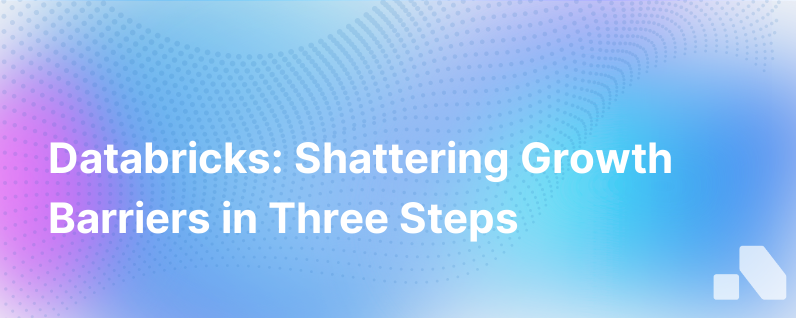
In the world of Big Data, traditional analytics and processing frameworks can leave businesses struggling to unlock their full potential. Databricks, a unified data analytics platform, is revolutionizing the way companies harness the power of data. By breaking down the barriers to growth, Databricks presents a triad of transformational advantages: comprehensive data integration, colossal processing power, and a collaborative workspace that transcends traditional limitations. Here's how Databricks is changing the game for organizations craving growth and innovation.
Comprehensive Data Integration for Seamless Operations
The Obstacle: Data Silos
For many organizations, data silos create a significant roadblock to comprehensive data analysis. Each department might be gathering a rich dataset, but when housed separately, the result is a fragmented view that negates the potential for insights that could be gleaned from a full spectrum analysis.
Databricks' Solution: Unifying Data Sources
Databricks offers a potent remedy for this common pitfall by providing a fully managed, scalable, and secure cloud-based data platform. This enables you to aggregate data from diverse silos — be it IoT sensors, online transactions, customer feedback, or operational logs — into a centralized repository. With this consolidation, Databricks ensures that data is no longer a scattered resource but a powerful, unified asset.
The Lakehouse architecture is intrinsic to Databricks' robust integration capabilities. By bridging the gap between data lakes and data warehouses, the Lakehouse paradigm allows businesses to manage all of their data in a single platform while still preserving the advantages of structured and unstructured data processing. With the Delta Lake open-source storage layer, data immutability, reliability, and quality control are baked into the process, ensuring that insights are drawn from data that is both accurate and up-to-date.
Colossal Processing Power to Handle Any Data Volume
The Obstacle: Scalability Challenges
As businesses grow, data volumes swell exponentially. Traditional data processing systems often falter under such expansion, struggling to scale effectively without a degradation in performance. Even cloud-native solutions can fall prey to bottlenecks that stymie growth and render real-time analytics a pipe dream.
Databricks' Solution: Unmatched Scalability and Speed
Enter Databricks, wielding an unrivaled ability to scale with your data needs. Built upon Apache Spark, Databricks takes advantage of a distributed computing framework that parallelizes data processing across clusters. Whether dealing with gigabytes or petabytes, Databricks effortlessly adjusts computational resources to maintain optimal performance.
Moreover, Databricks' Photon-powered Delta Engine brings a quantum leap in query performance over large data sets, enhancing the speed of data analytics workflows. This enhanced processing engine optimizes operations, slashing the time required for complex computations and empowering businesses to undertake ambitious data initiatives that were previously untenable.
Collaborative Workspace Cultivating Cross-functional Synergy
The Obstacle: Departmental Segmentation
The path from data to decisions involves various stakeholders, from data scientists to business analysts. In a segmented workspace, this could mean precious time lost in translation between departments, disjointed analysis, and duplication of effort.
Databricks' Solution: Cohesive Collaboration
Databricks dismantles this barrier by offering a collaborative workspace that facilitates synchronous workflows among data teams. With features like notebooks that support multiple languages (SQL, Python, Scala, R), it caters to the diverse skill sets within a team, promoting an inclusive environment.
The collaborative nature of Databricks extends to its integration with familiar tools like Tableau and PowerBI, enabling seamless transitions from data science to business intelligence. Teams can iterate on analyses, share insights, and build upon one another's work with simplicity and transparency.
This environment not only encourages more dynamic brainstorming and problem-solving but also hastens the path from raw data to actionable insights. By aligning the competencies of analysts, data scientists, and business stakeholders, Databricks fosters a culture of collaboration and continual learning that is indispensable for growth.
Wrapping Up: Databricks as a Catalyst for Expansion
In the digital age, your data strategy is inextricably linked to your growth trajectory. Databricks offers more than just a technical solution; it offers a transformative approach, finessing the hurdles that commonly stymie scalability, agility, and innovation.
Through its unified data analytics, Databricks is not only a tool but a strategic partner that enables you to realize the full potential of your data, ensuring it becomes your most valuable asset for growth. Whether you're grappling with data silos, scalability, or cross-functional alignment, Databricks stands as a beacon, guiding you through to a future where data challenges are a relic of the past, and boundless growth is the new standard.
About Aomni
Just like Databricks, Aomni strives to obliterate barriers — but focuses on the world of B2B sales. With real-time account research, actionable competitive insights, and personalized sales content that's crafted in a fraction of the usual time, Aomni equips sales teams to sell more strategically. By embracing intelligent tools like Aomni and Databricks, businesses can prepare for a future where growth is not just a goal, but an inevitable outcome.